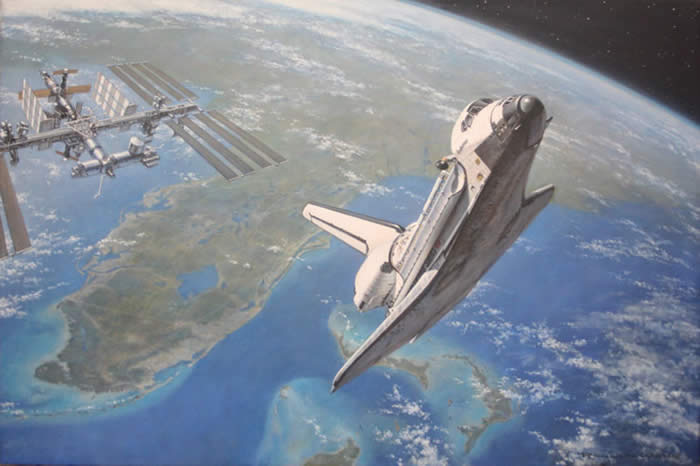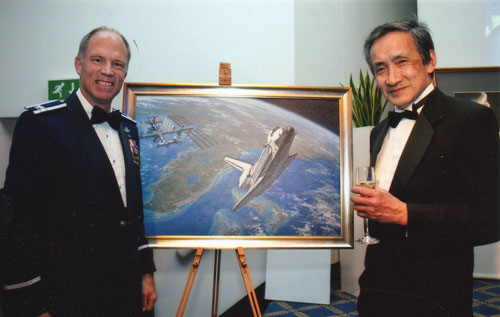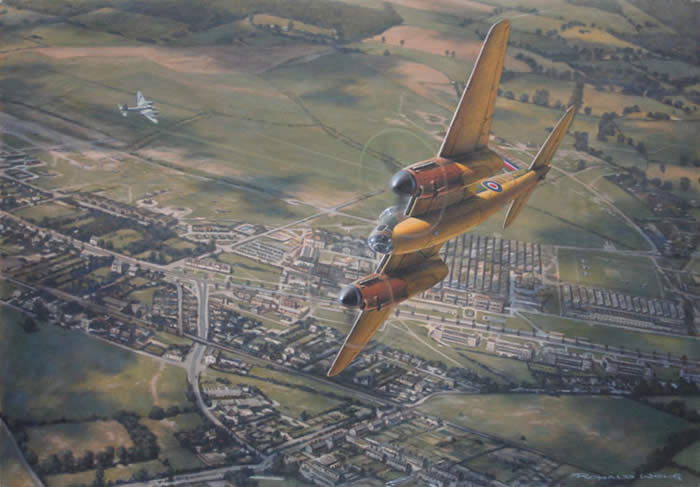|
|
|
The following article was published in the Summer 2011 issue of the Quaterly News, the official newsletter of the Guild of Aviation Artists. -------------------------------------------------------------- “Mission Accomplished”The Final Flight of the Space Ship Endeavour If you look towards the curve of the Earth, you can see that thin blue line against the sheer blackness of outer space. It is what makes all the difference between our Mother planet and the lifeless neighbouring bodies of the solar system: that frail membrane of gas and moisture, all of a few miles in thickness on a globe some 8000 miles in diameter and 25000 miles around, within which all earthly life lives and dies( and within which all aeroplanes fly!). The sunlit International Space Station sparkles in airless space and together with the Shuttle orbiter Endeavour, pass over the peninsula of Florida and the nearby islands of Bimini, the Bahamas and Bermuda, set in the startling blueness of the Caribbean some 250 miles below. Endeavour, having delivered its cargo, has undocked from the station and is establishing a vertical loop( London Eye style) around it from about 600 feet away, preparatory to descending back into the Earth’s atmosphere.
The painting( oil, 24 x 36 ins ) was commissioned to celebrate the triumphs, and to remember the tragedies, of the Space Shuttle programme. It looks forward to STS-134, the 134th and penultimate launch of the Shuttle projected, as I write, for April 29. The primary purpose of the mission is to deliver the Alpha Magnetic Spectrometer(AMS), which is designed to detect the presence of hypothetical “dark matter” in deep space, and is visible in the painting on the starboard main truss of the ISS, just inboard of the photovoltaic panels. The Space Shuttle was a long time coming, the first reusable spaceplane, which represented a new generation of winged spacecraft that could conduct missions in orbit and fly back down through the atmosphere and land in a conventional way. The first of a total fleet of six shuttle orbiters flew into space in April 1981. Now, 30 years later in 2011, the Space Shuttle is scheduled to retire from service after 135 launches, the final launch planned for June this year.. The Shuttle programme was originally conceived primarily to service a space station, but this was not to happen until the construction of the International Space Station starting in 1998. The ISS represents a joint effort involving 15 countries, many of them former adversaries, to establish a research station for the future, and is mankind’s toehold on the “Final Frontier”. A constraint on the composition of the painting was that the Shuttle should have its open cargo bay pointed towards the ISS as it went into its circum-ISS “loop”. This caused me some initial consternation as the relatively featureless thermal shield underside of the Shuttle would be uppermost in the painting. The alternative would be to take the view from the ISS, which would mean pushing the spacecraft, the main subject of the piece, more than 600 feet into the distance. But a little bit of mental gymnastics with pencil and paper soon yielded the satisfactory composition you see. I was ably assisted all the way by Astronaut Richard Searfoss who dutifully answered my many technical questions via e-mail as the painting progressed. The huge and very complicated ISS was another matter, and available images often showed contrasting features because for one thing its structure was still being added to and modified, such as with the placement of the AMS in the present mission. Rick was a Shuttle man, and when it came to the space station I was to a great extent left to my own devices. In a nutshell, the internet again came to my aid, as did some hefty volumes from the local library, in order for me to understand and correctly portray that ISS. And the evocative geography in the background? That big household atlas saw to that….. So creating this complex painting involved a steep learning curve from the start, and was very far removed from the reactive, monkey-see-monkey-do level of therapeutic picture painting. I have previously (QN, Summer 2008) suggested that having our viewpoint take to the air has irrevocably changed our perception of the world and of ourselves and opened a unique and dynamic new dimension for our painting which potentially elevates aviation art beyond the Lilliputian stylistic pretensions and struggles of earthbound art. Painting from the perspective of space takes this transformation yet a quantum jump further, and I thoroughly enjoyed doing it. Just the active visualisation and painting of the distant Earth itself was an emotional and humbling experience. It was a pleasure to finally meet up with Rick the Astronaut at the Gala Dinner last month held by the leading aviation charity Fly2Help at the Royal Aeronautical Society, when the painting was presented. You won’t often see me trussed up in a tux, so enjoy the photo of us at the sumptious event.
With Shuttle Astronaut Rick Searfoss at the Royal Aeronautical Society, London
And While I’m Here……I cannot be the only professional painter who has been keenly aware that our most interesting and challenging paintings often never see the light of day at the organized exhibitions, for the simple reason that the finished pieces tend to go straight to commissioning clients all over the world. So, the editor(s) willing, I take the opportunity to note here a second canvas which happened to share easel time with the above work. Soon after receiving the Shuttle commission I was contacted by the De Havilland Heritage Museum(aka Mosquito Museum) at Salisbury Hall, almost on my doorstep here in St Albans. The result was a commission for a painting to be centrepiece for fund-raising for the restoration of the Mosquito Prototype, presently in a disassembled state at the museum, with a deadline for a Reunion of Mosquito Aircrew in London. That I found myself plotting and painting this project more or less in parallel with the Shuttle painting may have something to do with the steep top-down aerial perspective adopted, which in the end served the painting very well.
The resulting painting ( oil, 21 x 30 ins )was unveiled at the reunion at the RAF Club on 16th April, and shows the Prototype W4050, newly fitted with the Merlin 72, winging over the De Havilland works at Hatfield Aerodrome in1943. The uprated Merlins gave the Mosquito outstanding performance, and at the controls during the engine trials was Geoffrey de Havilland Jr with Dick Whittingham as observer. As you might surmise, the greater labour in the painting actually went into laying out and detailing the aerodrome below as well as parts of Old Hatfield. Once again, I found myself trying to understand diverse images from a clutch old maps and murky aerial photographs which often displayed differing features in the landscape. I did try to mitigate some of the labour with useful cloud shadows, but in the end there really was no getting away from it, as the area portrayed is still very clear in the memories of the old Mosquito hands down at the museum. The flip side was that I had the attention and assistance of those very able people in recreating a detailed and historically accurate setting for the scene. Also, some building structures and the main roads in the area ( including the familiar A1)are still there to this day, just a few miles from my home, and in the painting I used their lines to intersect those of the Mosquito to impart energy to the composition. A dynamic composition for a very dynamic aircraft. Virtually the entirety of wartime Hatfield Aerodrome is visible in the painting, and notable features include the heavily camouflaged main buildings, the lack of runways (and the use of grass strips), and the false hedgerows laid out across the field to blend the aerodrome into the surrounding country. Bringing both past and future into the present, Ronald Wong GAvA |


